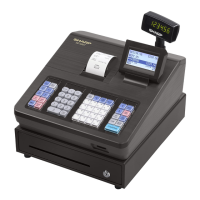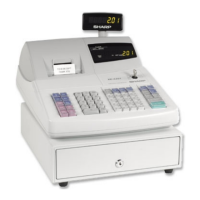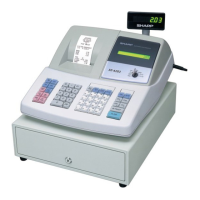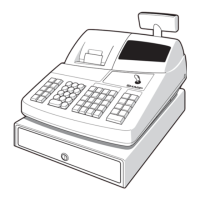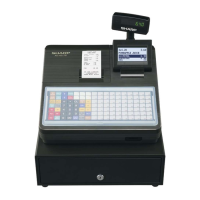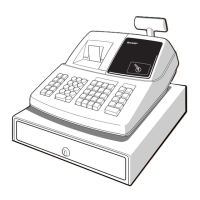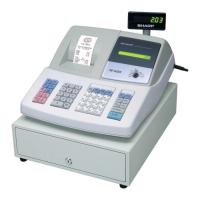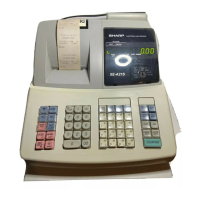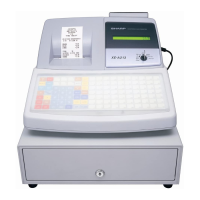XE-A202 Quick Start Guide
English
Where A to H represent the following choices:
Parameters A, B, C and D: Taxable status
Enter 0000 for non-taxable, 0001 for taxable 1, 0010 for taxable 2,
0100 for taxable 3, or 1000 for taxable 4.
Parameter E: Single Item Cash Sale (SICS) function
Enter 0 for normal or 1 for single item cash sale.
(If the SICS function is selected, upon entry of the sales amount into
the SICS department, the sale is finalized.)
Parameter F: + sign or - sign
Enter 0 for a positive department or 1 for a negative department.
Parameter G: Entry digit limit (0 to 7 digits)
Enter 0, 1, 2, 3, 4, 5, 6, or 7.
(Setting this parameter prevents the accidental entry of too large an
amount during a sale.)
Parameter H: Type of unit price entry
Enter 1 to allow open price entry, 2 to allow preset price entry, 3 to
allow open and preset price entries and 0 to inhibit the department key
entry.
Below are the most common examples for department setup when using tax
system types 3, 4, 5 and 6 (as set in “1 Selecting the Tax Calculation System”
above).
Setting department 1 for tax 4 GST/HST only:
10000071@ ! A
Setting department 1 for tax 4 GST and tax 1 PST:
10010071@ ! A
Setting department 1 for tax 4 GST and tax 2 PST:
10100071@ ! A
Setting department 1 for tax 4 GST and tax 3 PST:
11000071@ ! A
Setting department 1 for non-taxable:
00000071@ ! A
NOTE:
To program other departments just substitute another department key for
department 1 in the above examples.
In the above examples, + sign, normal department, 7 digits for entry digit limit, and
open price entry are also set.
4
Basic Programming (Continued)
2. Setting Tax Rates (%)
Specify a tax rate (%) for GST and PST on each taxable subtotal using the
following sequence:
s
➔
9
➔
@
➔
Tax number (1 to 4)* ➔
@
➔ R ➔
@
➔ Q ➔
s
➔
A
R: Tax rate (0.0000% to 100.0000%)
Q: Minimum taxable amount (0.01 to 999.99)
(Smallest amount for which tax must be collected.)
*Up to 4 types of tax are programmable.
To program a GST, use Tax 4; and to program two GSTs, use Tax 3 and 4.
To program a PST, use Tax 1; to program two PSTs, use Tax 1 and Tax 2; and to
program three PSTs, use Tax 1, 2 and 3.
Example:
GST rate 7% for Tax 4
s9@4@ 7 sA
Tax 4 7%
PST rate 8% and minimum taxable amount $0.21 for Tax 1
s9@1@8@21sA
Tax 1 8% Min. taxable
amount ($0.21)
You can also set the tax table instead of the % tax rate. If you need the tax table
programming, refer to the instruction manual.
3. Setting the department (taxable status and other status)
Finally, you need to associate the departments as taxable and non-taxable.
Merchandise can be classified into 99 departments. Items sold within these
departments can later be printed on a report that shows the quantities sold and
sales amounts classified by department. All items within a taxable department will
be charged tax upon entry.
You can specify the taxable status or other statuses (+/- sign, single item cash
sale function, entry digit limit and type of unit price entry) parameters for
department keys. Use the following key sequence.
For department 1 to 32
ABCDEFGH ➔
@
➔ Department key* ➔
A
*To program departments 17 to 32, press the department shift key before the
department key.
For department 33 to 99
Department code ➔
d
➔ ABCDEFGH ➔
@
➔
A
5
Now, you are ready!
Before Starting Entries
Set the mode switch to
the REG position.
Registration Example
(when selling department items by cash)
1. Enter your clerk code. (By default, clerk code 1 is
assigned.)
2. Enter the price for the first department item.
For example for 5.00, enter
5:
, and press the
appropriate department key.
For department 17 to department 32, press
D
first before pressing the department key.
For department 33 and above, enter the
department number using numeric keys, and
press
d
, then enter the price and press
d
again.
3. Repeat step 3 for all the department items.
4. Press
s
to display the amount due.
5. Enter the amount received from the customer.
(You can omit this step if the amount tendered is
the same as the subtotal.)
6. Press
A
, and the change due is displayed
(when the amount received was not entered,
total amount is displayed) and the drawer is
opened.
7. Tear off the receipt and give it to the customer
with his or her change.
8. Close the drawer.
Key operation
1L 5:! 825D"
Clerk code Price and dept. 1 Price and dept. 18
s 2:0 A
Amount tendered
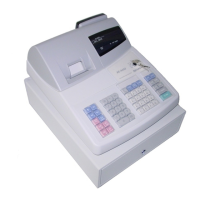
